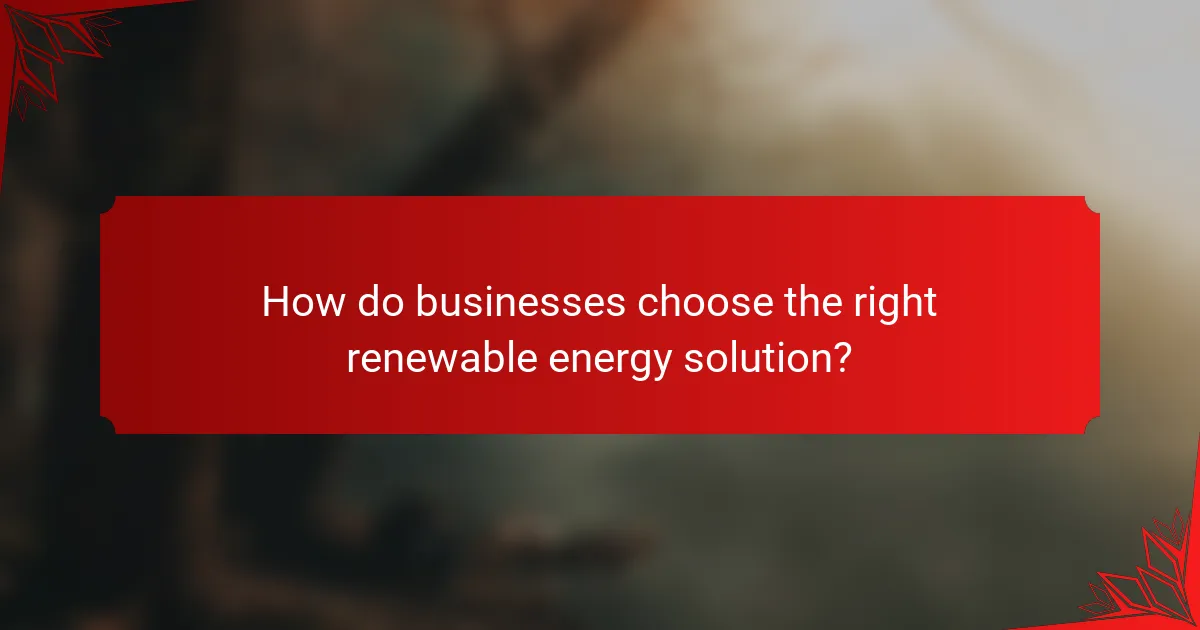Integrating renewable energy solutions, such as solar panels and wind systems, allows businesses to reduce their carbon footprints while achieving substantial cost savings. By embracing these sustainable practices, companies not only enhance their brand reputation and comply with regulations but also contribute positively to the environment and their communities.

How can businesses integrate renewable energy solutions?
Businesses can integrate renewable energy solutions by adopting technologies such as solar panels, wind energy systems, and energy storage solutions. These approaches not only reduce carbon footprints but also can lead to significant cost savings over time.
Solar panel installation
Installing solar panels allows businesses to harness sunlight to generate electricity. This can significantly lower energy bills, especially in regions with high solar exposure. Companies should consider factors like roof space, local incentives, and installation costs, which typically range from a few thousand to tens of thousands of dollars.
It’s essential to evaluate the return on investment (ROI), which can vary based on energy savings and available tax credits. Businesses may also explore leasing options to reduce upfront costs.
Wind energy systems
Wind energy systems, including small and large turbines, convert wind energy into electricity. Businesses in areas with consistent wind patterns may find this a viable option. Initial costs can be substantial, often exceeding tens of thousands of dollars, but long-term savings can be significant.
Before installation, companies should assess local zoning regulations and potential impacts on wildlife. Engaging with local authorities can help navigate these considerations effectively.
Energy storage solutions
Energy storage solutions, such as batteries, allow businesses to store excess energy generated from renewable sources for later use. This is particularly useful for managing energy supply during peak demand or outages. Costs for commercial battery systems can range from thousands to millions of dollars, depending on capacity.
When considering energy storage, businesses should evaluate their energy consumption patterns and potential savings. A well-designed system can enhance energy independence and reliability.
Power purchase agreements
Power purchase agreements (PPAs) enable businesses to buy renewable energy from a provider at a fixed rate, often lower than traditional utility prices. This arrangement can help companies manage energy costs without the need for upfront capital investment in renewable infrastructure.
Businesses should carefully review the terms of PPAs, including duration, pricing, and any penalties for early termination. Engaging legal counsel can ensure favorable terms and compliance with local regulations.
On-site generation
On-site generation refers to producing energy directly at the business location, typically through solar panels or wind turbines. This approach minimizes transmission losses and can provide energy security. Companies should assess their energy needs and available resources to determine the feasibility of on-site generation.
It’s beneficial to conduct a thorough energy audit to identify potential savings and efficiency improvements. Additionally, businesses should stay informed about local incentives that can offset installation costs.

What are the benefits of renewable energy for businesses?
Renewable energy offers several significant benefits for businesses, including cost savings, improved brand reputation, regulatory compliance, and enhanced energy independence. By adopting renewable sources like solar or wind, companies can reduce expenses and contribute positively to their communities and the environment.
Cost savings on energy bills
Switching to renewable energy can lead to substantial cost savings on energy bills. Businesses that invest in solar panels or wind turbines often see a reduction in their monthly energy expenses, sometimes by 20% to 50% over time. Additionally, many regions offer incentives or tax credits that can further lower initial investment costs.
To maximize savings, companies should consider energy efficiency upgrades alongside renewable installations. For example, implementing LED lighting or energy-efficient HVAC systems can reduce overall energy consumption, enhancing the financial benefits of renewable energy adoption.
Enhanced brand reputation
Utilizing renewable energy can significantly enhance a company’s brand reputation. Consumers are increasingly favoring businesses that demonstrate environmental responsibility, and a commitment to renewable energy can differentiate a brand in a competitive market. This positive perception can lead to increased customer loyalty and potentially higher sales.
Engaging in sustainability initiatives, such as community solar projects or partnerships with green organizations, can further bolster a brand’s image. Companies should communicate their renewable energy efforts through marketing and social media to effectively reach their audience.
Compliance with regulations
Many regions are implementing stricter regulations aimed at reducing carbon emissions, and adopting renewable energy can help businesses comply with these laws. By transitioning to cleaner energy sources, companies can avoid potential fines and penalties associated with non-compliance. This proactive approach can also enhance eligibility for government grants and incentives.
Staying informed about local and national regulations is crucial. Businesses should regularly review their energy strategies to ensure they align with evolving standards, such as the European Union’s Green Deal or similar initiatives in other regions.
Increased energy independence
Renewable energy sources can provide businesses with greater energy independence, reducing reliance on fossil fuels and external energy suppliers. This independence can lead to more stable energy costs and less vulnerability to market fluctuations. For example, companies that generate their own solar power can shield themselves from rising electricity prices.
To enhance energy independence, businesses should evaluate their energy needs and consider a mix of renewable sources. Combining solar panels with battery storage can ensure a reliable power supply, even during outages or peak demand periods.

What are the environmental impacts of renewable energy?
Renewable energy significantly reduces environmental impacts compared to fossil fuels. Its primary benefits include lower greenhouse gas emissions, conservation of natural resources, and improved air quality.
Reduction in greenhouse gas emissions
Renewable energy sources like solar, wind, and hydroelectric power generate electricity without emitting carbon dioxide and other greenhouse gases. This reduction is crucial for mitigating climate change and its associated risks.
For instance, transitioning to renewable energy can decrease emissions by up to 80% in certain sectors. Businesses adopting these technologies not only contribute to environmental sustainability but may also benefit from government incentives aimed at reducing carbon footprints.
Conservation of natural resources
Utilizing renewable energy helps conserve finite natural resources such as coal, oil, and natural gas. By relying on sources like sunlight, wind, and water, businesses can reduce their dependence on these depleting resources.
Moreover, renewable energy systems often require less water for operation compared to traditional power generation methods, which is vital in regions facing water scarcity. Companies should consider integrating renewable technologies to promote resource efficiency and sustainability.
Improvement in air quality
Switching to renewable energy sources leads to significant improvements in air quality by reducing pollutants released into the atmosphere. This shift can decrease respiratory diseases and other health issues related to air pollution.
For example, cities that have invested in wind and solar power have reported lower levels of smog and particulate matter. Businesses can enhance their community reputation and employee health by supporting cleaner energy initiatives.

What are the challenges of adopting renewable energy?
Adopting renewable energy presents several challenges that businesses must navigate, including high initial investment costs, the intermittency of energy sources, and regulatory hurdles. Understanding these obstacles is crucial for effective planning and implementation.
High initial investment costs
One of the primary challenges of adopting renewable energy is the high initial investment required for infrastructure and technology. Businesses may need to allocate substantial capital for solar panels, wind turbines, or energy storage systems, which can deter some from making the switch.
To mitigate these costs, companies can explore financing options such as power purchase agreements (PPAs) or leasing arrangements. These alternatives allow businesses to pay for renewable energy over time rather than upfront, making it more financially feasible.
Intermittency of energy sources
Renewable energy sources like solar and wind are inherently intermittent, meaning they do not produce energy consistently. This variability can lead to challenges in maintaining a stable energy supply, particularly for businesses that rely on continuous power.
To address this issue, companies can invest in energy storage solutions, such as batteries, to store excess energy generated during peak production times. Additionally, integrating multiple renewable sources can help balance supply and demand, reducing reliance on any single energy type.
Regulatory hurdles
Businesses often face regulatory hurdles when adopting renewable energy, including complex permitting processes and compliance with local and national regulations. These requirements can vary widely by region, impacting the feasibility and timeline of renewable energy projects.
Staying informed about relevant regulations is essential for successful integration. Companies should engage with local authorities and industry groups to understand the regulatory landscape and seek guidance on navigating potential obstacles. This proactive approach can streamline the adoption process and minimize delays.

How do businesses choose the right renewable energy solution?
Businesses can choose the right renewable energy solution by assessing their energy needs, evaluating local incentives, and comparing available technology options. This structured approach helps ensure that the selected solution aligns with operational goals and financial considerations.
Assessing energy needs
Understanding energy needs is crucial for businesses looking to adopt renewable energy. Companies should analyze their current consumption patterns, peak usage times, and future growth projections. This assessment helps identify the scale and type of renewable energy solution that would be most effective.
For instance, a manufacturing facility may require a larger solar array compared to a small retail store. Conducting an energy audit can provide insights into specific requirements and potential savings from renewable sources.
Evaluating local incentives
Local incentives can significantly impact the financial viability of renewable energy projects. Businesses should research available tax credits, grants, and rebates offered by federal, state, or local governments. These incentives can reduce upfront costs and improve return on investment.
For example, in the United States, the Investment Tax Credit (ITC) allows businesses to deduct a percentage of the cost of installing solar energy systems from their federal taxes. Understanding these incentives can help businesses make informed decisions about their renewable energy investments.
Comparing technology options
When selecting a renewable energy solution, businesses must compare various technology options, such as solar panels, wind turbines, and biomass systems. Each technology has its own advantages, costs, and suitability based on location and energy needs.
For instance, solar panels are often ideal for regions with high sunlight exposure, while wind turbines may be more effective in areas with consistent wind patterns. Evaluating the total cost of ownership, including installation, maintenance, and expected lifespan, is essential for making the best choice.

What are the local renewable energy initiatives in the United States?
The United States has numerous local renewable energy initiatives aimed at promoting sustainable energy sources and reducing carbon emissions. These initiatives vary by state and often include incentives for solar, wind, and other renewable energy projects.
State-Level Incentives
Many states offer financial incentives for businesses and homeowners to adopt renewable energy technologies. These can include tax credits, rebates, and grants that significantly lower the upfront costs of solar panels or wind turbines. For example, states like California and New York provide substantial incentives to encourage solar installations.
Community Solar Programs
Community solar programs allow multiple participants to invest in a single solar project, making renewable energy accessible to those who cannot install solar panels on their properties. These programs are particularly beneficial in urban areas where space is limited. Participants typically receive credits on their utility bills based on their share of the energy produced.
Renewable Portfolio Standards (RPS)
Renewable Portfolio Standards require utilities to obtain a certain percentage of their energy from renewable sources. These standards vary by state, with some states aiming for ambitious targets, such as 50% or more renewable energy by 2030. Compliance often drives investment in local renewable energy projects, fostering job creation and economic growth.
Local Energy Cooperatives
Energy cooperatives are community-owned organizations that provide renewable energy solutions tailored to local needs. These cooperatives often focus on solar and wind projects, allowing members to invest in and benefit from local energy generation. They can offer competitive rates compared to traditional utilities, promoting energy independence.



